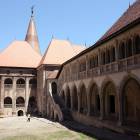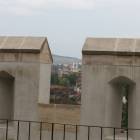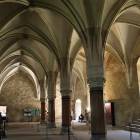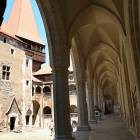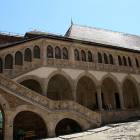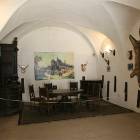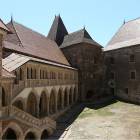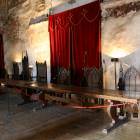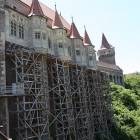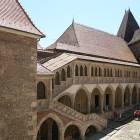The Gothic castle of Hunyad dinasty
The Hunyad or Corvin dynasty is as disputed among Romanians and Hungarians as Transylvania itself. This North-Western province of Romania was for many centuries either part of Hungary or subject to the Hungarian crown, but is demographically vastly Romanian. As was the case with Britain under the Normans, Transylvania had a Romanian population and a Hungarian and German nobility. To complicate things further, large populations of settlers were brought in by the Hungarian crown. Among them were the Szekelys, brought in what is now center of Romania, to guard the strategic point of Carpathian curvature, or the Saxons (Germans), brought in to establish towns and stimulate trade. Both groups had a positive impact on the region and maintained their cultural identity. Besides these, both parties went through periods of forced assimilation, with large communities changing their names, Christian denomination or language, in order to be accepted by the majority.
Such was the case with the family of John Hunyadi (Iancu de Hunedoara for Romanians and Hunyadi Janos for Hungarians). He came from a noble family with Romanian or Cuman origins, that was in time completely converted to Hungarian language and culture. This prince of Transylvania claimed to descend from Basarab, the mythical founder of Wallachia (Southern Romania). The other name associated with this family and with this castle is Corvin and comes from a legend with a magical raven (in Romanian, “corb”). John Hunyadi was one of the most respected generals in the Hungarian army and he actively took part in a succession war for the throne in Budapest. Due to this succession scandal and because the king he was supporting was not yet legal of age, John Hunyadi became a de facto ruler of Hungary. And his son, Matei Corvin (Mathias Corvinus) became the most glorious king in Hungarian history.
Both of these kings had a major impact on the aspect of Corvin Castle and on the region in general. Despite their origins, they spoke Hungarian and acted as Hungarians, but since they were technically born in Romanian cities, both nations now claim them as part of their history. Which is another sign of appraisal for the two men of arms. The Corvin Castle in Hunedoara is a perfect image of the glory and influence of the Hunyadi dynasty. It looks impressive and hard to conquer even today, and looked probably overwhelming in the 15 century, when it had already much of today’s size.
The castle is a splendid example of Gothic architecture. It is fully prepared to withstand the military challenges like a fortress, with high walls, a surrounding moat (now almost dried out) and a mobile bridge. The high towers and the position on top of a rocky hill offer perfect visibility all around, while numerous windows and fire halls offered opportunities to respond to a siege. The 30 m deep fountain in the interior yard could also prolong the period for which the castle could resist.
But the exterior and inside decorations also met the standards of representation for a royal residence. Much of what we see in terms of decorations is more recent, from the various restorations carried out in XIX century, when new tile roof is added as well as new battlements. The original furniture was moved to other residences by later owners and eventually lost. The two kings that marked the beginning of this construction, John Hunyadi and Matthias Corvinus had their contributions to the severe style of the building, that is rejoiced by some Renaissance elements. Especially the interior yard has balconies with beautiful stone carvings, that made it ideal scenery for several Romanian and Hollywood movies.
The rooms and cellars are numerous, allowing for a large number of servants, bureaucrats and defending troops. But two main chambers are of special size and played an important official role. The Chamber of Diet was used for local Parliament-like assembly and for official receptions, while the Knights’ Chamber was used for banquets and dinners. In both there are elements of Gothic architecture, vaulted arches with cornerstones in the form of carved medallions with the coat of arms of Corvin family, clerestory windows. Both halls are used as museum rooms, exhibiting an armory collection, a statue of Janosz Hunyadi, fragments of frescoes with contemporary kings from Romanian County and Moldova, as well as medieval uniforms.
Together with Bran Castle, this is an excellent example of Medieval and Gothic architecture, being two of the best preserved monuments of this kind in Europe. On top of that, they both benefit from the association with the myth of Dracula, which is associated with the real historic character Vlad the Impaler, who ruled in the Romanian County. In this case, a popular legend about a period in arrest spend by Vlad inside the castle was enough to make the site even more popular, the visual aspect also helping for such grim associations. Hunedoara is 400 km NW of capital Bucharest and 440 km from Budapest. The closest major city is Sibiu, a Medieval German town, at 120 km, from which you can get on the national road through Sebeș.
Mai multe despre: Architecture, Romania • Charles I of Anjou • donjon • Dracula • gothic architecture • Hunyad Castle • Hunyadi Janos • John Hunyadi • Matthias Corvinus • ribbed vault • Transylvania • Vajdahunyad vara • vaulted arch- Home Page
start page - Architecture
landmark buildings - Sacred architecture
places of worship - Nature
landscape photography - Concert
performing artists - Christmas
Santa Claus pictures
- Jooble
jobs for photographers - Escape
an out of control blog - Merry Christmas
The best organizer of Christmas parties - Astro photo
Eclipse hunting and astrological photography







